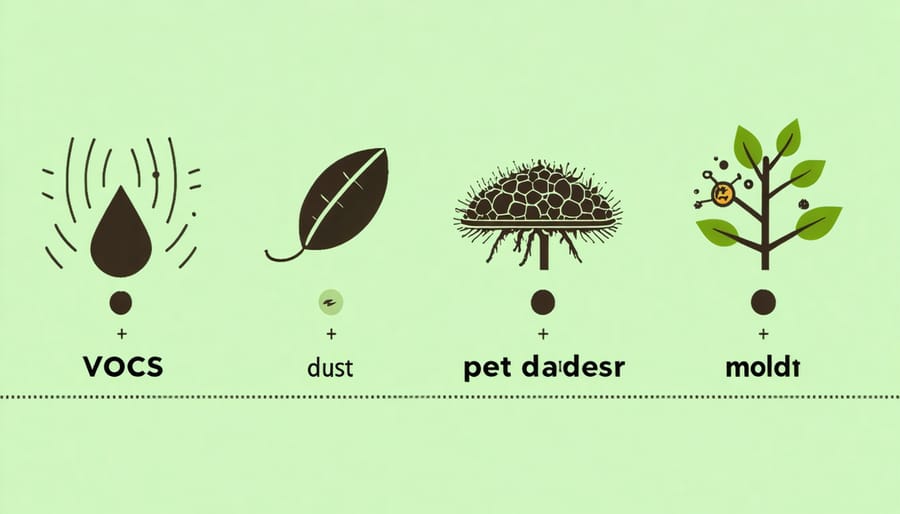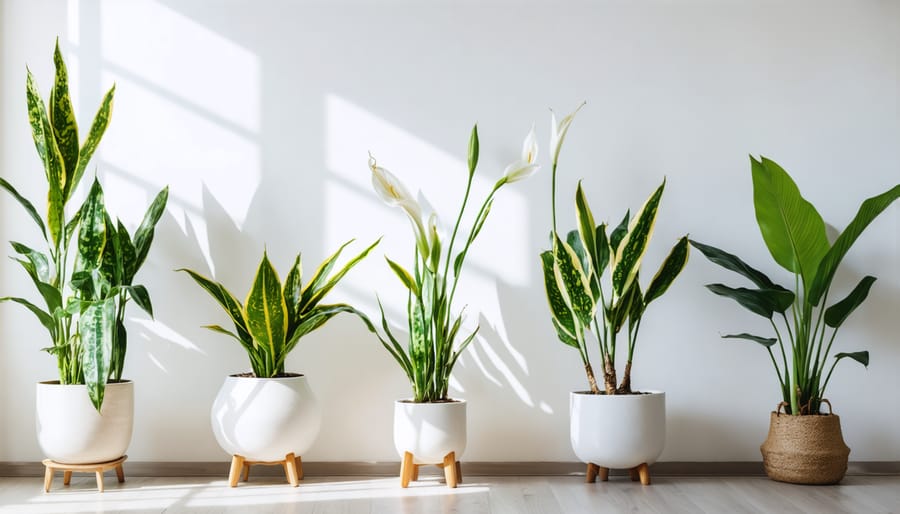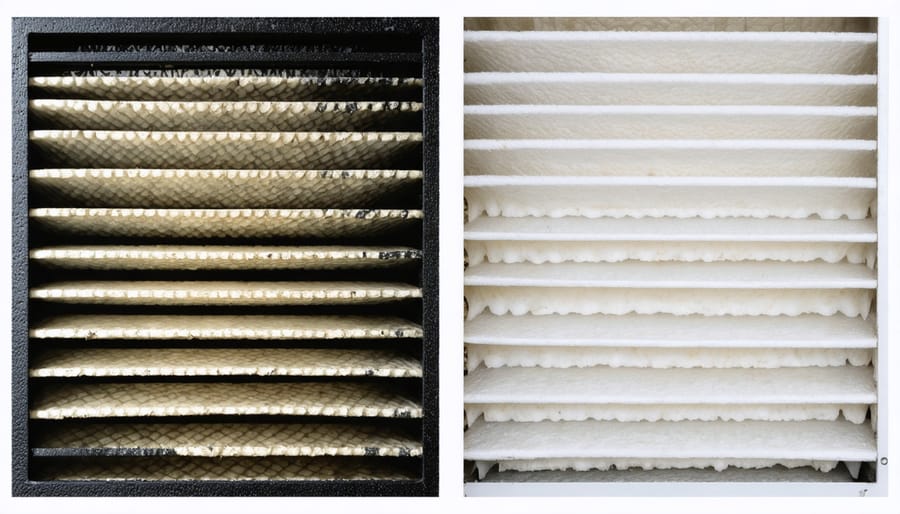Open windows daily for 15-20 minutes to create cross-ventilation, even in winter, dramatically reducing indoor pollutants and stale air. Install high-quality HEPA air purifiers in bedrooms and living spaces, targeting particles as small as 0.3 microns. Clean or replace HVAC filters monthly, and consider professional duct cleaning annually to boost your home’s air quality. Maintain indoor humidity between 30-50% using dehumidifiers or humidifiers to prevent mold growth and reduce airborne allergens.
The air inside our homes can be up to five times more polluted than outdoor air, making these improvements essential for health and comfort. From dust mites to volatile organic compounds (VOCs), indoor air pollutants significantly impact our daily well-being. By implementing these proven strategies, you’ll create a healthier living environment while potentially reducing respiratory issues and allergic reactions.
Common Indoor Air Pollutants in Your Home

Hidden Sources of Indoor Air Pollution
While we often focus on outdoor pollution, many surprising sources of air contamination lurk right inside our homes. Traditional cleaning products, though effective, can release harmful volatile organic compounds (VOCs) into your air. Consider switching to eco-friendly cleaning products to minimize these emissions.
Your furniture might also be a sneaky pollutant source. New pieces, particularly those made with pressed wood or synthetic materials, can off-gas formaldehyde and other chemicals for months. Even your beloved scented candles and air fresheners might be contributing to poor air quality through artificial fragrances and particulate matter.
Building materials like paint, carpet, and certain types of insulation can release chemicals long after installation. That “new home smell” often indicates the presence of VOCs. Even everyday activities like cooking with non-stick pans or using craft supplies can introduce unexpected pollutants into your living space.
Being aware of these hidden sources is the first step toward creating a healthier indoor environment. By identifying these subtle culprits, you can make informed choices about the products and materials you bring into your home.
Health Effects of Poor Indoor Air
Poor indoor air quality can significantly impact your health and well-being in ways you might not even realize. Many people experience immediate symptoms like headaches, dizziness, and irritation of the eyes, nose, and throat when exposed to polluted indoor air. If you’re feeling unusually tired or having trouble concentrating at home, your air quality might be the culprit.
Long-term exposure to indoor air pollutants can lead to more serious health issues, including respiratory diseases, heart problems, and even certain types of cancer. Children, elderly individuals, and those with existing health conditions are particularly vulnerable to these effects.
Common indoor air pollutants like mold spores can trigger allergic reactions and asthma attacks, while volatile organic compounds (VOCs) from household products may cause persistent respiratory issues. Poor ventilation can also lead to increased carbon dioxide levels, making you feel sluggish and less productive throughout the day.
Beyond physical health, poor air quality affects your comfort and quality of life. Unpleasant odors, excessive humidity, and airborne particles can make your living space feel less inviting and impact your daily activities and sleep quality.
Natural Solutions for Better Air Quality
Air-Purifying Plants That Actually Work
Bringing nature indoors isn’t just about aesthetics – certain plants are proven air-purifying powerhouses. Here are the most effective options for cleaner indoor air, backed by science.
The Snake Plant (Sansevieria) is a champion at removing toxins like formaldehyde and benzene, even during nighttime. It’s also incredibly low-maintenance, making it perfect for beginners or busy households. Place one in your bedroom for improved air quality while you sleep.
Spider Plants are another excellent choice, particularly effective at tackling carbon monoxide and xylene. These hardy plants produce plenty of offspring, giving you free air purifiers to spread throughout your home. They thrive in hanging baskets with indirect sunlight.
Peace Lilies stand out for their ability to remove common household pollutants, including ammonia from cleaning products. While beautiful, remember they’re toxic to pets, so place them in pet-free areas. They prefer shady spots and regular misting.
For maximum benefit, consider adding a Bamboo Palm to larger spaces. These elegant plants excel at filtering out benzene and trichloroethylene, common in household products. Keep the soil consistently moist but not waterlogged.
To maintain your air-purifying garden: dust leaves weekly to maximize their filtering capability, ensure proper drainage to prevent mold growth, and rotate plants quarterly for even light exposure. Start with one plant per 100 square feet and gradually increase based on your space and needs.

Ventilation Strategies That Make a Difference
Keeping your home well-ventilated doesn’t have to be complicated. During warmer months, create cross-ventilation by opening windows on opposite sides of your home during cooler morning or evening hours. This natural airflow helps flush out stale air and brings in fresh oxygen.
In winter, try the 5-5-5 rule: open windows for just 5 minutes, in 5 rooms, every 5 hours. This quick air exchange minimizes heat loss while still refreshing your indoor air. For extra efficiency, turn off your heating during these brief ventilation periods.
Make the most of your bathroom and kitchen exhaust fans by running them for 15-20 minutes after showers or cooking. This helps remove excess moisture and airborne particles that can affect air quality. Consider installing timer switches to automate this process.
Strategic placement of fans can boost air circulation. Position a box fan facing outward in one window to push stale air out while another window draws fresh air in. During temperature extremes, use your HVAC system’s fan setting to keep air moving without heating or cooling.
For year-round ventilation, consider installing trickle vents in windows or a whole-house ventilation system. These provide constant, controlled fresh air exchange without significant energy loss. Remember to adjust your ventilation strategy based on outdoor air quality and weather conditions.
Smart Technology Solutions
Choosing the Right Air Purifier
Selecting the right air purifier doesn’t have to be complicated. Start by measuring your room’s square footage – this is crucial for choosing a unit with appropriate coverage. Look for the CADR (Clean Air Delivery Rate) rating, which should match or exceed your room size for optimal performance.
Consider your specific needs. If allergies are your main concern, focus on purifiers with true HEPA filters that capture 99.97% of particles as small as 0.3 microns. For households with pets or cooking odors, look for models with activated carbon filters that tackle unwanted smells.
Pay attention to these key features when shopping:
– Noise levels (especially important for bedrooms)
– Filter replacement costs and frequency
– Energy efficiency (look for ENERGY STAR certification)
– Smart features like air quality sensors and auto mode
– Portability if you plan to move it between rooms
For standard living rooms (300-400 square feet), aim for purifiers with CADR ratings of at least 200. Smaller rooms can work well with lower CADR ratings. Remember that higher fan speeds clean air faster but generate more noise.
Don’t forget to factor in long-term maintenance costs. While some models might seem budget-friendly initially, expensive replacement filters can make them costly over time. Choose a purifier that balances upfront costs with maintenance expenses for the best value.
Air Quality Monitors Worth Your Money
Investing in a reliable air quality monitor can help you track and improve your indoor air quality effectively. Here are some top picks that offer great value for your money:
For budget-conscious buyers, the Temtop M10 provides accurate readings for particulate matter (PM2.5) and comes in under $100. It’s portable and easy to use, making it perfect for spot-checking different rooms in your home.
If you’re looking for more comprehensive monitoring, the Airthings Wave Plus is worth considering. While pricier at around $230, it tracks radon, CO2, VOCs, temperature, humidity, and air pressure. The smartphone app makes it easy to monitor trends and receive alerts when air quality drops.
For smart home enthusiasts, the Amazon Smart Air Quality Monitor integrates seamlessly with Alexa devices and provides real-time monitoring of key pollutants. At about $70, it’s an affordable way to automate your air quality management.
The IQAir AirVisual Pro stands out for its professional-grade accuracy and detailed forecasting features. Though expensive at around $280, it’s ideal for those with specific health concerns or who need highly accurate readings.
Pro tip: Look for monitors that measure multiple pollutants and offer smartphone connectivity for the best value. Place your monitor in frequently used rooms at breathing height, and away from windows, doors, or direct airflow for the most accurate readings.
Remember that even basic monitors can help you identify air quality issues and verify whether your improvement efforts are working.
Maintenance Tips for Cleaner Air
Essential Cleaning Routines
Regular cleaning is your first line of defense against poor indoor air quality. Start by vacuuming at least twice a week using a machine equipped with a HEPA filter, which traps microscopic particles other vacuums might miss. Pay special attention to high-traffic areas and don’t forget to vacuum upholstered furniture where dust and allergens love to hide.
Dusting should be done with microfiber cloths rather than feather dusters, which often just redistribute dust into the air. Work from top to bottom in each room, starting with ceiling fans and light fixtures, then moving to furniture and baseboards. Remember to dampen your microfiber cloth slightly to maximize dust capture.
Mop hard floors weekly using a damp mop to prevent particles from becoming airborne. For best results, use natural cleaning solutions like vinegar and water, which don’t release harmful chemicals into your air. Don’t overlook often-forgotten spots like window tracks and door frames, which can harbor significant dust and debris.
Washing bedding weekly in hot water (at least 130°F) helps eliminate dust mites and other allergens. Include pillows and curtains in your regular washing rotation – aim for every 3-4 months for these items. Additionally, regularly clean or replace HVAC filters, and wipe down air vents to prevent the circulation of accumulated dust throughout your home.
Remember to clean your cleaning tools too! Regularly empty vacuum canisters, wash microfiber cloths, and replace mop heads to maintain their effectiveness in improving your indoor air quality.
HVAC Maintenance Schedule
Regular HVAC maintenance is crucial for keeping your indoor air fresh and healthy. Here’s a simple, season-by-season guide to help you maintain your air conditioner and heating system effectively.
Spring (March-May):
• Replace or clean air filters
• Clean air vents and registers
• Schedule professional HVAC inspection
• Check and clean outdoor AC unit
• Inspect and clean dehumidifier
Summer (June-August):
• Replace air filters monthly
• Clean condensate drain lines
• Check thermostat functionality
• Monitor humidity levels
• Clear debris around outdoor units
Fall (September-November):
• Clean or replace air filters
• Inspect heating system
• Clean chimney and vents
• Check weather stripping
• Schedule professional maintenance
Winter (December-February):
• Replace air filters
• Check heat exchanger
• Monitor indoor humidity
• Clean humidifier components
• Inspect ductwork for leaks
Monthly Tasks:
• Visual inspection of vents
• Check filter condition
• Clean return air grilles
• Monitor system performance
• Listen for unusual noises
Remember to keep a maintenance log and set calendar reminders for these tasks. While some maintenance can be DIY, always consult professionals for complex repairs or annual inspections. This schedule helps prevent air quality issues and extends your system’s lifespan.

Creating a healthier indoor environment doesn’t have to be overwhelming or expensive. By implementing the strategies we’ve discussed – from regular cleaning and ventilation to incorporating air-purifying plants and maintaining optimal humidity levels – you can significantly improve your home’s air quality. Remember to start with the basics: establish a consistent cleaning routine, ensure proper ventilation, and control moisture levels. Then, gradually incorporate additional measures like air purifiers or HVAC upgrades as your budget allows.
The key is to take action, even if it’s just one small step at a time. Monitor your progress by paying attention to how you and your family feel – reduced allergies, better sleep, and increased comfort are all signs that your efforts are paying off. Don’t forget to regularly maintain any systems or devices you’ve implemented, as this will ensure their continued effectiveness.
Your home should be a sanctuary where you can breathe easily and feel your best. By making indoor air quality a priority, you’re investing in your family’s health and well-being for years to come.
